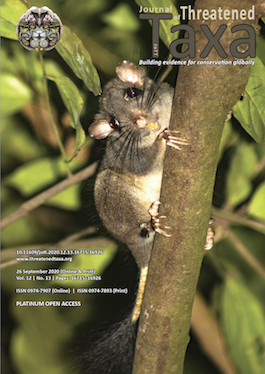University campuses can contribute to wildlife conservation in urbanizing regions: a case study from Nigeria
DOI:
https://doi.org/10.11609/jott.6316.12.13.16736-16741Keywords:
Camera trap, Cricetomys gambianus, detectability, habitat use, Ichneumia albicauda, occupancy modeling, sustainability, wildlife managementAbstract
Globally, colleges and universities are increasingly mandating sustainability and environmental protection into their practices. To date, such institutions have focused their efforts on recycling and energy-use reduction and less on the management and conservation of wildlife and wildlife habitats. However, in an increasingly urbanizing world, well-managed campuses can provide habitat and even refuge for wildlife species. On the campus of a sustainability-minded university in Nigeria, we used camera traps to determine the presence of wildlife and used occupancy modeling to evaluate factors that influenced the detectability and habitat use of two mammals for which we had sufficient detections: White-tailed Mongoose Ichneumia albicauda and Gambian Rat Cricetomys gambianus. Our intent was to gather baseline data on campus wildlife to inform future research and make recommendations for maintaining wildlife populations. We detected wildlife primarily within less-disturbed areas that contained a designated nature area, and the presence of a nature area was the key predictor variable influencing habitat use. No measured variables influenced detectability. This study supports other research that highlights the importance of undisturbed or minimally disturbed natural habitats on university campuses for wildlife, especially in increasingly built-up and developed regions. We recommend that institutions of higher education devote greater resources to making campuses wildlife-friendly and increase opportunities for students to engage in campus-based wildlife research and conservation and other sustainability-related programs.
References
Admasu, E., S.J. Thirgood, A. Bekele & M.K. Laurenson (2004). Spatial ecology of white-tailed mongoose in farmland in the Ethiopian Highlands. African Journal of Ecology 42: 153‒159. https://doi.org/10.1111/j.1365-2028.2004.00498.x
Ajayi, S.S. (1977). Field observations on the African giant rat Cricetomys gambianus Waterhouse in southern Nigeria. East African Wildlife Journal 15: 191‒198. https://doi.org/10.1111/j.1365-2028.1977.tb00397.x
Aneesh, K.S., C.K. Adarsh & P.O. Nameer (2013). Butterflies of Kerala Agricultural University (KAU) campus, Thrissur, Kerala, India. Journal of Threatened Taxa 5: 4422–4440. https://doi.org/10.11609/JoTT.o2870.4422-40
Baker, L.R., T.W. Arnold, O.S. Olubode & D.L. Garshelis (2011). Considerations for using occupancy surveys to monitor forest primates: a case study with Sclater’s monkey (Cercopithecus sclateri). Population Ecology 53: 549–561. https://doi.org/10.1007/s10144-011-0274-5
Bocsi, T., P.S. Warren, R.W. Harper & S. DeStefano (2018). Wildlife habitat management on college and university campuses. Cities and the Environment 11(1): Article 1.
Calder, W. & R.M. Clugston (2003). International efforts to promote higher education for sustainable development. Planning for Higher Education 31: 30‒44.
Dariye, E.P. (2016). Woody plant diversity and composition in two nature areas on the American University of Nigeria campus, Yola, Adamawa State. Unpublished undergraduate thesis. American University of Nigeria, Yola, Adamawa State, Nigeria.
Dombrosky, J. & S. Wolverton (2014). TNR and conservation on a university campus: a political ecological perspective. PeerJ 2: e312. https://doi.org/10.7717/peerj.312
Hines, J.E. (2006). PRESENCE–Software to estimate patch occupancy and related parameters. USGS-PWRC. https://www.mbr-pwrc.usgs.gov/software/presence.html
Hubbard, R.D. & C.K. Nielsen (2009). White-tailed deer attacking humans during the fawning season: a unique human–wildlife conflict on a university campus. Human-Wildlife Conflicts 3: 129–135. https://doi.org/10.26077/409s-td37
Knight, M.H. (1988). Thermoregulation in the largest African cricetid, the giant rat Cricetomys gambianus. Comparative Biochemistry and Physiology 89: 705–708. https://doi.org/10.1016/0300-9629(88)90856-0
Krasny, M.E. & J. Delia (2015). Natural area stewardship as part of campus sustainability. Journal of Cleaner Production 106: 87–96. https://doi.org/10.1016/j.jclepro.2014.04.019
MacKenzie, D.I., J.D. Nichols, J.A. Royle, K.H. Pollock, L.L. Bailey & J.E. Hines (eds.) (2006). Occupancy Estimation and Modeling: Inferring Patterns and Dynamics of Species Occurrence. Elsevier, San Diego, CA.
McCleery, R.A., R.R. Lopez, L.A. Harveson, N.J. Silvy & R.D. Slack (2005). Integrating on-campus wildlife research projects into the wildlife curriculum. Wildlife Society Bulletin 33: 802–809. https://doi.org/10.2193/0091-7648(2005)33[802:IOWRPI]2.0.CO;2
Normile, D. (2004). Conservation takes a front seat as university builds new campus. Science 305(5682): 329–331. https://doi.org/10.1126/science.305.5682.329
Ramesh, T. & C.T. Downs (2015). Impact of land use on occupancy and abundance of terrestrial mammals in the Drakensberg Midlands, South Africa. Journal for Nature Conservation 23: 9–18. https://doi.org/10.1016/j.jnc.2014.12.001
Ramli, R. (2004). Green areas and avian species richness in University of Malaya campus, peninsular Malaysia. Malaysian Journal of Science 23: 7‒13. https://mjs.um.edu.my/article/view/8498
Schuette, P., A.P. Wagner, M.E. Wagner & S. Creel (2013). Occupancy patterns and niche partitioning within a diverse carnivore community exposed to anthropogenic pressures. Biological Conservation 158: 301–312. https://doi.org/10.1016/j.biocon.2012.08.008
Tennent, J., C.T. Downs & M. Bodasing (2009). Management recommendations for feral cat (Felis catus) populations within an urban conservancy in KwaZulu-Natal, South Africa. South African Journal of Wildlife Research 39: 137‒142. https://doi.org/10.3957/056.039.0211
Waser, P.M. (1980). Small nocturnal carnivores: ecological studies in the Serengeti. African Journal of Ecology 18: 167‒185. https://doi.org/10.1111/j.1365-2028.1980.tb00640.x
van Weenen, H. (2000). Towards a vision of a sustainable university. International Journal of Sustainability in Higher Education 1: 20‒34. https://doi.org/10.1108/1467630010307075
Published
Issue
Section
License
Authors own the copyright to the articles published in JoTT. This is indicated explicitly in each publication. The authors grant permission to the publisher Wildlife Information Liaison Development (WILD) Society to publish the article in the Journal of Threatened Taxa. The authors recognize WILD as the original publisher, and to sell hard copies of the Journal and article to any buyer. JoTT is registered under the Creative Commons Attribution 4.0 International License (CC BY), which allows authors to retain copyright ownership. Under this license the authors allow anyone to download, cite, use the data, modify, reprint, copy and distribute provided the authors and source of publication are credited through appropriate citations (e.g., Son et al. (2016). Bats (Mammalia: Chiroptera) of the southeastern Truong Son Mountains, Quang Ngai Province, Vietnam. Journal of Threatened Taxa 8(7): 8953–8969. https://doi.org/10.11609/jott.2785.8.7.8953-8969). Users of the data do not require specific permission from the authors or the publisher.





